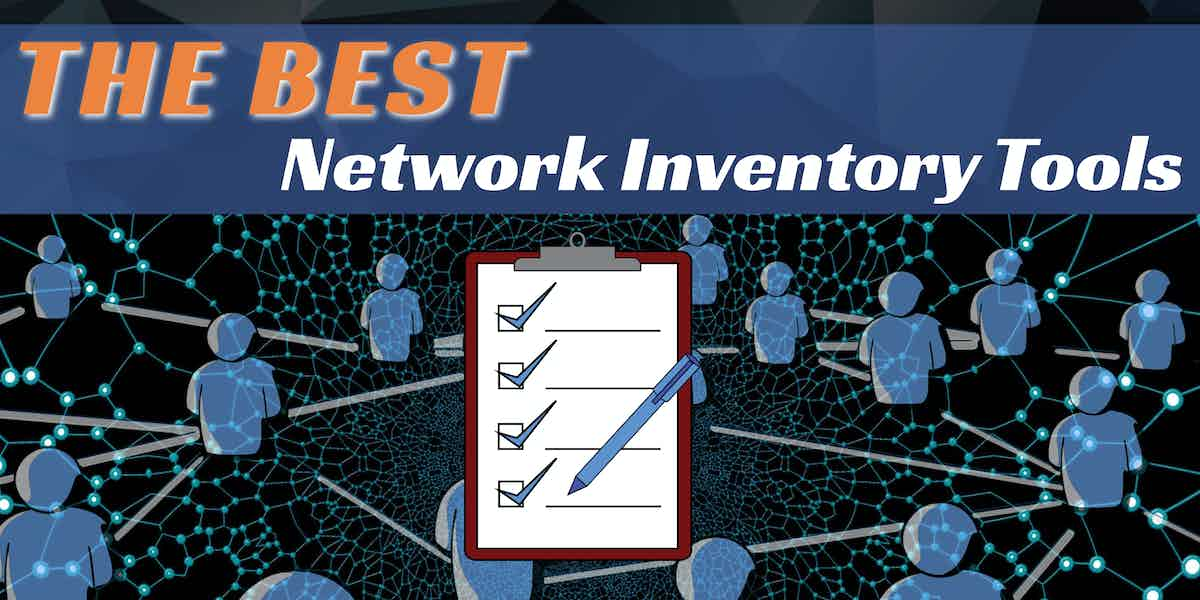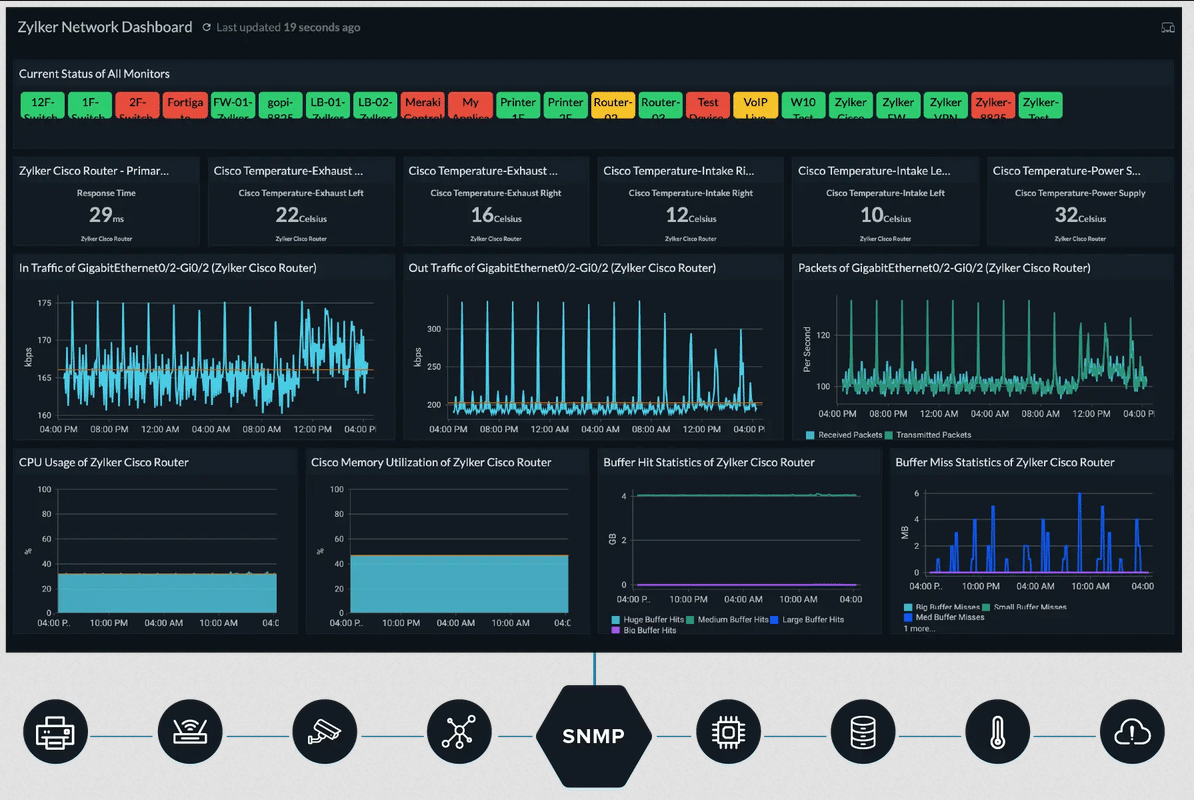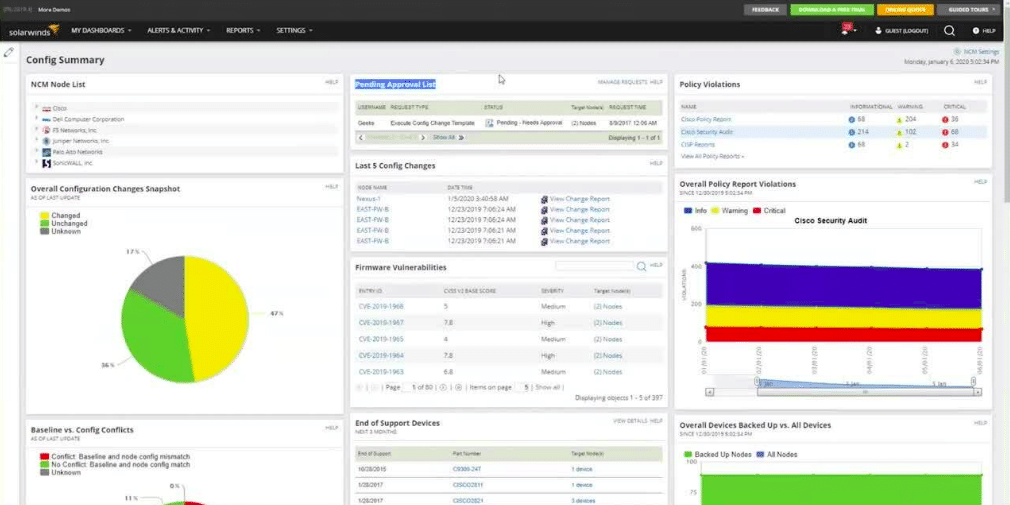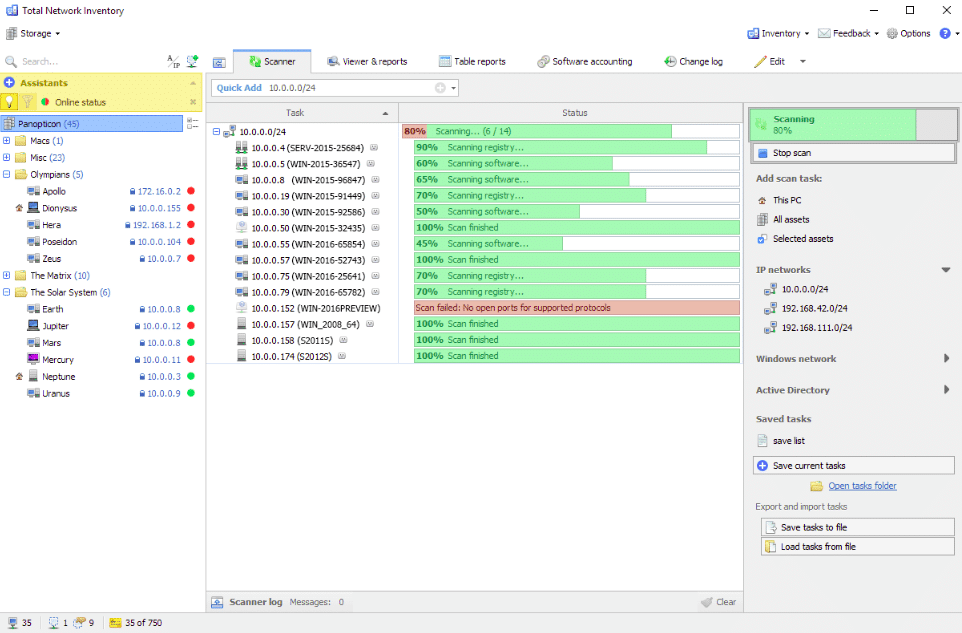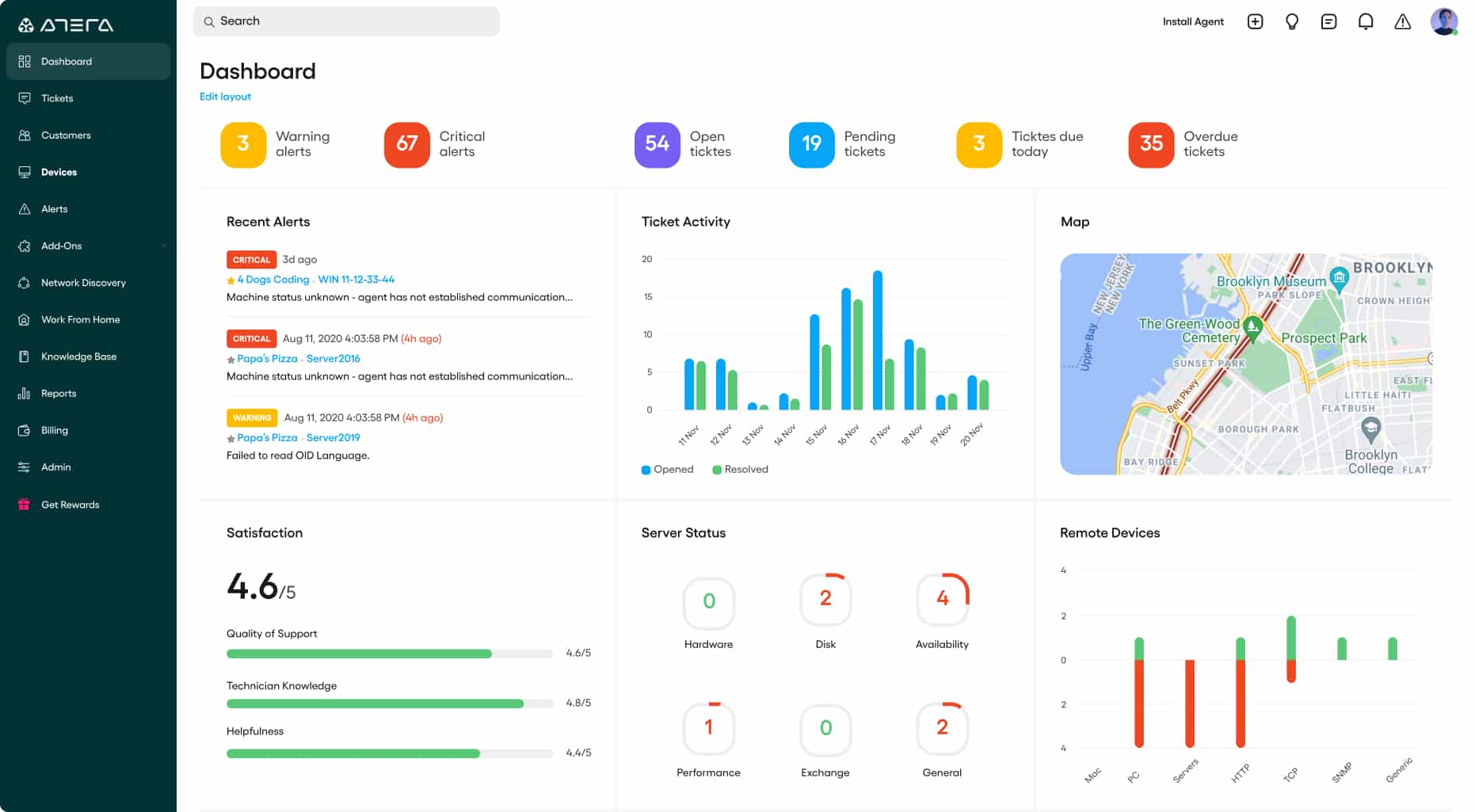Network inventories include a list of network devices and assets that a company owns and operates. For small network companies, maintaining the network inventory list is not a big task. But, for large corporations, it is essential to purchase tools that track all network assets and offer detailed information about its model and firmware version.
Every device in the network has an expected service life which should also be properly recorded in the network device inventory. Similarly, there is other information like the cost of acquiring it, license expiration, and more that must be tracked for the efficient operations of the device.
Network inventory software is available in different shapes and sizes. Thus, it is vital to choose the right tool for your business.
Here we have highlighted some of the top network inventory management tools, their features, benefits, and drawbacks, which will help in making the right decision.
What is Network Inventory Management?
Network Inventory Management is a process under which network administrators can track and record all IT devices and network assets. The main purpose of Network inventory management tools is to keep the administrators updated about the device, its configurations, license expiry date, and other information about network assets.
With the advancement of technology, the acquisition and decommissioning of network assets are on the rise.
In case, you have a smaller network, your business can manually monitor and track the network assets. But, with large companies and their expanding networks, things are different. It gets difficult for IT staff to manually monitor and track devices which is why most large companies are switching to Network inventory management tools.
Network administrators can now easily scan and map the networks using these tools. Further, it helps save their time and resources. If you have a large network, we recommend investing in some of the below-listed network inventory tools for quick results and better performance.
Why Do We Need Network Inventory Tools?
Network inventory tools are a must for most businesses as they help keep track of all assets and network resources. These tools provide detailed information about the device, its presence, configurations, license status, and more.
IT networks are dynamic systems and are constantly growing and upgrading. Thus, it is highly necessary to have a network inventory tool for your business to gather and timely update data related to network assets.
As the technology is constantly updating, it has become crucial for businesses to maintain an accurate record of the IT system’s current state and record every minor change.
With larger businesses, performing manual updates is more difficult as it comprises more devices. Hence, investing time and money into network inventory tools is the best option.
- Faster Data Collection With network inventory tools, one can collect, analyze, and report detailed information about network assets faster. Also, the data collection process is done automatically by the tools at a faster rate. Thus, it saves time and minimizes efforts spent on inventory tasks.
- Quick Decisions The tool helps administrators in faster data collection and report generation. Based on the detailed report for each device or asset, the network administrators can take quick decisions and work on areas that need fixing.
- Asset tracker A few network inventory management tools also provide an asset tracker feature. Using this advanced feature, one can easily keep track of both hardware and software assets.
Methodology for Selecting the Best Network Inventory Tools
Network inventory tools help keep track of network infrastructure as well as aid in monitoring and management of IT assets in an efficient way. The tools help rapidly spot potential issues and assist in making better plans for growth and expansion in the future. Since there are many tools available in the market, choosing the right one can be a daunting task.
Maintaining the network inventory list is not a difficult job for small network companies. However, it is crucial for big corporations to invest in tools that keep track of every network asset and provide specific details about its model and firmware version. There are various factors that one must consider when selecting the best network inventory tools, such as cost-effectiveness, compatibility with existing systems, and more. Hence, we have shared a methodology that will help you make an informed decision.
- Check if the selected tool has the ability to identify all assets connected to the network automatically.
- Does it offer scan options?
- Can it keep track of device status and availability in real-time?
- Is monitoring across a network or the internet available with your selected tool?
- Check if it offers good controls at a fair price and gives value for money.
- Check if it can record the expected service life of each device in the network device inventory.
- Do not miss out to check if free trials or no-cost assessments or a demo system is available.
- Does it offer control to administrators to prevent unauthorized users from altering the device’s configurations?
The Best Network Inventory Tools
If you are looking for a Network Inventory tool, do not miss the one that automatically discovers and scans all network devices. Further, look for more features available in these tools that help track all changes and updates. Watch over your infrastructure with some of the below-listed popular network inventory tools.
1. ManageEngine Network Configuration Manager – FREE TRIAL
ManageEngine Network Configuration Manager excels in network device inventory management by enabling users to create multiple groups based on criteria such as backup status, compliance status, and configuration conflicts.
Key Features
- Automated Configuration Management: Automatically manage and deploy network configurations, saving time and reducing errors.
- Compliance Audits: Perform regular compliance audits to ensure network configurations meet industry standards.
- Real-Time Change Tracking: Track network changes in real time to quickly identify and resolve issues.
- Backup and Restore: Easily backup and restore device configurations to prevent data loss and ensure business continuity.
- User Access Control: Define user roles and access permissions to enhance security and prevent unauthorized changes.
- Multi-Vendor Support: Manage network devices from multiple vendors seamlessly within a single platform.
- Detailed Reports: Generate detailed reports for compliance, change management, and performance metrics.
- Customizable Alerts: Set up customizable alerts to get notified about critical network events and issues.
These dynamic groups update automatically to reflect changes in operational statuses, ensuring that users always have up-to-date information. For example, a device that resolves a startup-running configuration conflict will automatically move to the appropriate group. This dynamic grouping helps streamline the monitoring process, saving time and effort in compiling and updating device information.
Why do we recommend it?
ManageEngine Network Configuration Manager excels in automating configuration management and ensuring compliance, making it a top choice for network administrators looking to streamline operations and enhance security.
Additionally, the tool allows users to track all configuration changes, view change details, and analyze trends over time. This centralized platform enhances control over network changes, making configuration and change management more efficient and reliable.
Who is it recommended for?
This tool is ideal for network administrators and IT professionals managing complex network environments with devices from multiple vendors, needing robust compliance and configuration management.
Pros:
- Automated Processes: Streamlines network configuration management, reducing manual effort and errors.
- Compliance Assurance: Regular audits help ensure your network configurations meet industry standards.
- Real-Time Monitoring: Provides immediate insights into network changes, aiding quick issue resolution.
- User Role Management: Enhances security by allowing detailed control over user access and permissions.
Cons:
- Complex Initial Setup: The initial configuration can be time-consuming and complex.
Start by downloading a 30-day free trial.
EDITOR'S CHOICE
ManageEngine Network Configuration Manager is our top pick for a network inventory tool because this package discovers and documents all network devices and then enforces their security. The tool scans the settings of each network device, which often includes security measures, such as logging requirements and access control lists for network segmentation. The tool provides an interface that lets you set up a library of standard configurations for devices. You will have different settings for different types of devices but also different configurations depending on where on the network each device is located. The Network Configuration Manager provides an easy-to-use interface to back up your device configurations. The console for the package includes a library management system that indexes all stored configuration images, making it easier to select the right image to reapply. This service continuously scans devices and compares the settings of each of its designated stored backup. If there is a difference between the two, the Network Configuration Manager will restore the backup and wipe out any unauthorized changes. This is an important security function because weakening the configurations of network devices is a well-known first step implemented by intruders to facilitate their movement around a network.
Download: Get a 30-day FREE Trial
Official Site: https://www.manageengine.com/network-configuration-manager/download.html
OS: Windows Server, Linux, and AWS
2. Site 24×7 Network Monitoring Tool – FREE TRIAL
Site 24×7 Network monitoring tool is a robust SaaS platform capable of monitoring your device status as well as network traffic. It comes with several comprehensive features essential for monitoring enterprise networks. It starts by scanning with SNMP and delivering clear visibility into the device along with the interface level. The tool makes sure that it covers all the essential parameters of network resources and generates insights highlighting the potential issues.
With the help of this tool, you can even set threshold limits for all the important performance metrics at the interface and device levels. Thus, allowing you to respond appropriately to any breaches and maintain control over the network’s performance.
Key Features
- Single console monitoring
- Auto-discovery and real-time alerts
- SNMP trap processing
- Supports integration with third-party tools
Why do we recommend it?
The tool is not a standalone package but an all-in-one service that offers monitoring network availability, performance, traffic, and network configuration management (NCM) all together. With this tool, enterprises can keep track of every single network component, and endpoint, and pinpoint faults and other critical network issues faster.
Who is it recommended for?
Businesses of all sizes can invest in Site24x7 and choose from the different plans based on their budget. All its modules and packages include a network monitoring feature, so small and large businesses can use it for their own good.
Pros:
- Uses SNMP to automatically discover all devices present in a network or specific IP range
- Offers granular visibility into devices and maps all networks using information from the network inventory
- It is a user-friendly monitoring tool that supports infrastructure, sensor, VoIP, network, and real user monitoring in a single console
- Provides instant notifications for security misconfigurations and comprehensive reports
Cons:
- Users may take time to explore all the features and options offered by the tool as it is quite comprehensive
Start your Site24x7 Network Monitoring fully functional 30-day free trial.
3. Spiceworks
With Spiceworks, you have to no longer spend extra money as it is a free, quality network device inventory tool. Also, it is quite easy to operate your cloud environment using the tool as it runs on a cloud-friendly system.
Key Features
- Automatically discover device data
- Scanning features
- Compatible with Windows, Mac computers, routers and switches, printers, etc.
- Monitors device storage
- Spiceworks Inventory is easy to set up
- Insightful reporting
- Team Management
- Multi‐site Support
- Ticket Collaboration
- Activity Monitoring
- Alert features
- IT Asset Management
- Compliance Management
- Configuration Management
- Automated Routing
Why do we recommend it?
Spiceworks is an excellent choice for businesses, especially small to medium-sized ones, looking for a comprehensive yet cost-effective solution. One of its most attractive features is that it’s free, allowing businesses to avail of high-quality network inventory features without incurring any expenses.
Get access to detailed information, including storage capacity, antivirus feature is supported or not, etc., automatically with its excellent features. It also supports scanning capabilities that allow businesses to track and inventory each cloud service. You can run scheduled scans and update the frequency level.
Even if you have a small business and run a tight budget, feel free to use Spiceworks as it offers unlimited use on unlimited devices.
Further, there is no need to compare pricing plans with Spiceworks as it is available as a free option and starts scanning inventory right after set up.
Spiceworks is compatible with Windows and Mac computers. They also support other features like custom reporting, schedule scanning, Inventory with Help Desk, etc. The only drawback is that one requires add-ons to increase functionality.
Who is it recommended for?
Spiceworks is a fitting solution for businesses of all sizes, particularly small and medium enterprises that have budget constraints but don’t want to compromise on quality. Given its extensive features, it’s also ideal for IT departments and network administrators who require a tool that offers device data discovery, storage monitoring, compliance management, and more.
Pros:
- Allows creating custom reports
- Users can schedule scans and adjust the frequency level
- Provides a channel for clients to conduct queries and share concerns without worrying about the cost.
- Offers an unlimited amount of service tickets for every user.
- Available as an app for iOS and Android devices
- Backed by a large help community
- Allows management of tickets raised by clients
- Tracks agent’s performance
- Allows creating a centralized knowledge base
Cons:
- It requires add-ons to increase functionality that can frustrate users.
4. SolarWinds Network Configuration Manager
SolarWinds Network Configuration Manager (NCM) is an easy-to-use network inventory tool with powerful network configuration, features, and compliance management. You can also plug it into the SolarWinds Orion console, i.e., you can run NCM along with other SolarWinds tools.
Key Features
- Automatic device discovery
- Configuration backup
- Network compliance
- Vulnerability assessment and Scanning
- Activity Monitoring
- Integrates with Network Performance Monitor
- Threat Response
- Fast Disaster Recovery
- Device life-cycle management
- Phone and email support services
- Single consolidated command center
- Meets SLA requirements
- Change Monitoring
- Firmware Upgrades
- Configuration Backup and Restore
Why do we recommend it?
SolarWinds Network Configuration Manager (NCM) stands out as a comprehensive tool for network configuration and compliance management. Its extensive features, ranging from automatic device discovery, threat response, and network compliance, to firmware upgrades and rapid disaster recovery, make it a holistic solution for network administrators.
The purpose of designing NCM was to meet SLA requirements and monitor all network issues. It further offers consistency across multiple devices and manages compliance.
Another feature of NCM that makes it a top choice is administrators can quickly scan and detect configuration policy violations. It can also import devices for management and automatically update information as changes are made to the devices.
Other notable features of NCM include network automation, discovering devices with a weak password, highlighting assets with no backup, restoring configurations directly within the NCM console, and self-document setting values. All these features make it one of the best Network Inventory Tools.
Who is it recommended for?
SolarWinds NCM is ideal for IT departments and businesses that need to maintain a consistent and compliant network configuration across multiple devices. Given its robust auditing capabilities, it’s particularly suitable for organizations that are under regulatory constraints and need to ensure consistent policy adherence.
Pros:
- Instantly detect out-of-process changes.
- Allows monitoring and auditing network devices from a single dashboard
- Provides insights for Palo Alto Networks, Cisco ASA, and Cisco Nexus
- Deploys standardized configurations and corrects violations
- Provides comprehensive visibility and discovers vulnerabilities
- Full-time availability
- Generates customizable reports, covering configuration changes, policy compliance, etc.
- Scans and detects configuration policy violations
Cons:
- Requires working on access control list compliance
- Traditional architecture must be changed.
Click here to download your SolarWinds Network Configuration Manager (NCM) fully functional free trial.
5. Total Network Inventory
Total Network Inventory (TNI) is one of the best network inventory management solutions compatible with Windows, OS X, Linux, FreeBSD, ESX/ESXi-based computers, and other network devices. It has the ability to scan all single nodes, devices, and Active Directory structures.
Key Features
- Scans and audits remote computers
- Compatible with Windows, macOS X, Linux, FreeBSD computers, and other network devices
- Tracks all files and folders of a network device
- Flexible reporting
- Set up automatic network inventory in minutes
- Supports scheduled scanning
- Creates configuration snapshot for comparing and detecting changes
- Network mapping
- Monitors online status of different systems
- Tracks information about users
- Task scheduler
- Report sharing
- Alerts/Notifications
- Compliance Management
- Configuration Management
- IT Asset Management
- License Tracking
Why do we recommend it?
Total Network Inventory is a top recommendation in the network inventory management category due to its comprehensive feature set. It excels in scanning and auditing remote computers, supporting multiple operating systems, and offering flexible reporting. Its ability to create configuration snapshots and track hardware and software changes sets it apart.
With TNI, get access to detailed information available on hardware, operating system, user accounts, etc., in the different report sections. Users can also create, export, and print flexible reports using the convenient tool. Another notable feature of Total Network Inventory is it allows quick detection and browsing of changes in hardware and software.
Further, users can create and view network maps, store multiple passwords for different assets and protocols, record the real-time online status of assets, and more.
Who is it recommended for?
Total Network Inventory is recommended for IT professionals and organizations seeking efficient network management. It’s ideal for those who need detailed hardware and software information, scheduled scanning, compliance management, and the ability to create customized reports. Whether you’re managing a small network or a large enterprise, TNI offers the tools needed for effective IT asset management.
Pros:
- Displays all software installed on the network
- Supports various devices and protocols, including SNMP and Telnet protocols.
- It is an easy to install network inventory with a user-friendly interface
- Scans all network devices
- Users can move, store, or archive inventory data as per the need
- Allows grouping and commenting
- Users can create complex or customized reports
- Scan and print your own barcodes
- Create and view a network map
- Monitors and controls hardware health indicators
Cons:
- There are no problems and are suitable for small-to-medium organizations.
6. Network Asset Tracker Pro
Network Asset Tracker Pro is a comprehensive inventory solution that enables businesses to scan network nodes and track records. Also, you can get complete information about different operating systems, hotfixes, and running processes on remote PCs, hardware, and software using the convenient tool.
Key Features
- Strong reporting module
- Scans network nodes
- Automatically detects changes
- Uses logon script for scanning remote computers
- Stores Inventory Data In Database and tracks changes
- Offers up-to-date hardware information
- Audit Management
- Inventory Management
- Supplier Management
Why do we recommend it?
Network Asset Tracker Pro is highly recommended for businesses looking for a comprehensive inventory solution. Its strong reporting module, the ability to automatically detect changes, and the use of logon scripts for remote computer scanning make it a standout choice.
Network Asset Tracker Pro is compatible with Windows 10, Windows 8, Windows 7, Windows 2008, Windows Vista, Windows 2003, Windows XP, Windows 2000, Windows NT, Windows Me, Windows 98 (with WMI CORE) and supports no special hardware requirement.
Users can also generate quality reports using the powerful reporting module that further helps save time.
Network Asset Tracker Pro is trusted by most users as it provides detailed information on SNMP-enabled Network Devices, software, and other OS-related information related to shared resources and service packs.
Who is it recommended for?
Network Asset Tracker Pro is the ideal choice for businesses and IT professionals in need of robust network inventory management. It is especially suitable for those seeking detailed insights into their network infrastructure, including information about operating systems, hotfixes, hardware, and software on remote PCs.
Pros:
- Scans all the nodes of your network
- Offers detailed information about the operating system, hotfixes, hardware, and software
- Supports a Powerful reporting module where you can check the history of scans, highlight changes, create custom columns, and more.
- Compatible with Windows NT version up to Windows 10
- Saves time when preparing asset reports
Cons:
- No drawbacks were found for Network Asset Tracker Pro.
7. Atera
Atera is another popular network inventory tool that can run scripts and manage alerts. Further, the tool supports RMM, reporting, help desk, live chat, and billing features. Atera is a complete package and is best suited for Managed Service providers (MSP).
Key Features
- Ideal for Managed Service Provider (MSP)
- Supports professional services automation module (PSA)
- Monitors systems remotely
- Atera allows tracking multiple networks at the same time
- Offers network asset discovery service
- Automatically creates a network inventory
- Alerts and updates on noticing network changes
- Tracks device performance
- Minimalistic interface
- Supports flexible pricing model
- Track SLAs and maintenance tasks
- Reporting and Analytics
- Remote Monitoring and Management (RMM)
- Patch Management
- Help Desk and Ticketing
- Contract and Service Management
Why do we recommend it?
Atera is a highly recommended network inventory tool for several reasons. It offers a comprehensive package with features such as remote monitoring and management (RMM), professional services automation (PSA) module support, and a minimalistic interface for ease of use.
Another notable feature of Atera is it supports the professional services automation module (PSA) responsible for MSP manager support. The tool automatically generates network inventory and instantly updates if it notices network changes.
You can also create and send bills/invoices to multiple users at the same time using Atera. The convenient and easy-to-use tool also helps track device performance and updates on missing or removed devices.
Who is it recommended for?
Atera is best suited for Managed Service Providers (MSPs) looking for an all-in-one solution. Its support for professional services automation and features like remote monitoring, patch management, help desk and ticketing, and billing make it an ideal choice for organizations that offer IT services to multiple clients. Atera’s multi-language support, mobile accessibility, integration capabilities with third-party apps, scheduled automated reports, live chat, and intuitive ticketing system make it a versatile tool suitable for both technicians and clients.
Pros:
- Seamless monitoring of Windows, Mac, and Linux systems
- Eases the billing and invoice creation process. Users can send an invoice to multiple customers simultaneously
- Available in multi-language format
- Atera can be accessed on mobile devices
- Supports integration with third-party apps
- Access to create scheduled automated reports
- It has commendable notification functions
- Supports live chat feature
- The ticketing system is intuitive and available for both technicians and clients
- Quickly detects errors and bugs
Cons:
- Lacks automated remediation features
- Users can get confused when setting up a ticketing system
- Lacks Azure AD support
Final Thoughts
Network inventory tools are used by businesses to track and record all network assets. This further helps in quick decisions, saves time, and quick data collection. If your business has a small network, you can also try to manually track and monitor network assets.
But, with large organizations, it is best to purchase or invest in a quality network inventory tool as managing large data manually is not an easy task. With the help of the above-listed tools, network administrators can easily scan and map the networks.
As the technology is constantly updating, there is an urgent need for a tool that provides an accurate record of the IT system’s current state.
But, choosing a network inventory tool is not so simple. There are various factors one must consider before choosing a tool for tracking and recording network assets. To make it easy for you, we have shortlisted a few popular network inventory tools that comprise most of the factors.
Using these tools, users can track all devices present on the network, who supplied them, and which firmware versions are supported by the network.
Network inventory management tools help in scanning, compiling, and recording data about each network device or asset. Choose from the shared-list of network inventory tools as per need and budget.

